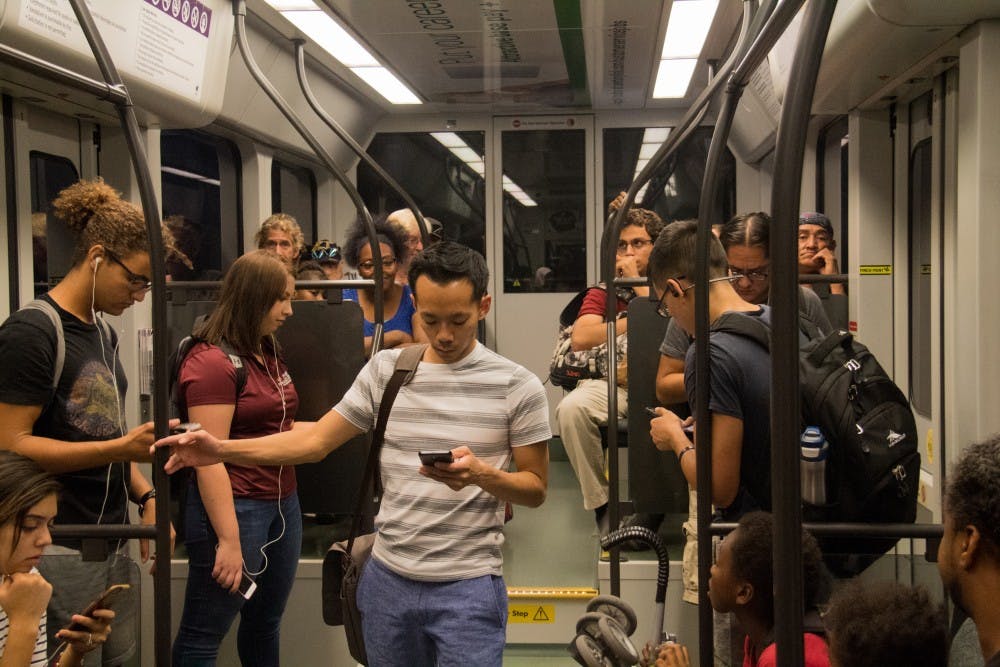The Valley Metro lightrail presents a variety of safety concerns that inhibit some in the ASU community from feeling comfortable riding, students say.
Students have reported groping, theft, public intoxication and other criminal behavior that they say make them feel unsafe taking the light rail, despite its proximity to the Tempe and downtown Phoenix campuses and reasonable cost.
This was the case for freshman criminology major Winter Roberts, who took the light rail back from Tempe one night this semester. She said that within minutes of getting on the crowded train, she was groped by a man behind her who fled before she could identify him.
Her case is not unique; many light rail riders, especially women, fear assault on the train cars. As reported by the Phoenix Business Journal, many women and students perceive the light rail as unsafe as a result of hearing stories like Roberts's, which left her unwilling to use the light rail again.
“People do not feel safe,” said Phoenix interim Mayor Thelda Williams.
But Valley Metro, the agency that runs transit services in the Phoenix area, says reports of crimes on buses and light rail are overblown.
“According to Valley Metro, crimes like assaults and robberies on buses are relatively rare," according to a 2017 12news report. "In the last nine months, Valley Metro said there has been less than 20 such incidents per quarter (three months).”
This statistic might seem low, but it may not indicate that incidences like those mentioned above are rare, according to the Chicago Tribune. Occurrences such as groping and petty theft are often underreported to authorities, said experts in the article.
Lexie Guccione, a Red Line train rider interviewed by the Chicago Tribune, said she did not report an assault she experienced on public transit because she was not sure if it was criminal, which is a common thought, according to authorities.
The article stated that under-acknowledged and under-documented sexual harassment incidences on public transportation have become "normalized."
Women are not alone in their discomfort on the light rail. Freshman nursing major Ryan Hughes said that his encounter with the light rail has been only negative. His experiences have ranged from homeless men trying to fight him outside of the train, to a passenger punching the window behind his seat. Despite this, Hughes said that these events won't stop him from riding the public transportation system.
"I just take it and hope that nothing happens," said Hughes.
In Arizona, the Valley Metro light rail was named one of the longest systems in the U.S. at 26.3 miles. It is also the thirteenth busiest rail system, clocking in at 16.2 million annual riders according to the American Public Transportation Association.
When first introduced, the rail was a new and convenient way for those living in the city to travel from place-to-place while saving gas and energy. Valley Metro is continuing to make steps towards a safer system through its new improvements and safety precautions.
In an effort to better the rail system, Phoenix approved a $600,000 budget to increase safety and security measures. In the last year, it rolled out things like Respect the Ride, its code of conduct and Educational Characters, which explains what’s right and wrong behavior for the light rail.
Valley Metro also added fare stripping, which are orange stripes along the platforms that require anyone past the lines to have paid for a ticket, said the organization's public information specialist, Brittany Hoffman. A portion of the budget will be dedicated to more security along the rail line, including frequent ticket and car checks that will ensure all rules are being followed inside and around the light rail.
Valley Metro will be releasing an app at the end of 2018 called Alert Valley Metro, Hoffman added. The app will allow passengers to anonymously report incidences that take place on the light rail that prompt concern. It will also alert riders about delays and other notifications that may impact their ride. Alert Valley Metro will ensure that assaults will not go unnoticed.
“Those are just different ways that we can enhance service and also help make light rail riders feel safer,” Hoffman said.
Reach the reporter at myarmusg@asu.edu and follow @gannonmikenna on Twitter.
Like The State Press on Facebook and follow @statepress on Twitter.




